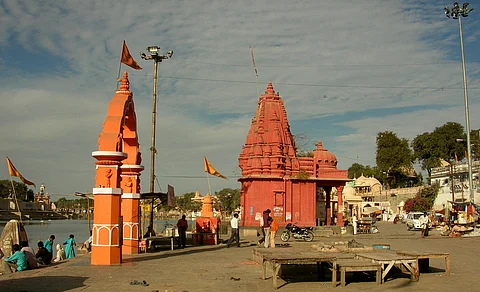
- Destinations
- Experiences
- Stay
- What's new
- Editor’s Picks
- Responsible Tourism
- CampaignsCampaigns
- Subscribe

This historical city, the capital of the ancient Avanti, is a popular pilgrimage site of Madhya Pradesh. It is also a commercial and cultural centre, steeped in memories of the famous Sanskrit poet Kalidasa. Here is a list of things to see and do in the vibrant city.
Located on the bank of the Shipra River, the multi-storied temple is now approached through a grand corridor called the Mahakal Lok. The present temple is said to have been built in the 18th century after the earlier one was destroyed, and exhibits mixed architecture. The sanctum sanctorum within the multi-storied temple is dedicated to Mahakaleshwara Shiva, one of the 12 jyotirlingas worshipped across India. There are idols of Parvati, Ganesha and Kartikeya too. The upper tiers have shrines dedicated to other incarnations of Shiva, namely Omkareshwar and Nagchandreshwar. Located within the temple complex is a water tank called Koti-tirtha Kunda. The temple holds varous festivals through the year, especially in the Hindu calendar month of Shravan.
This is a relatively modern temple near the Mahakal temple. About 18 feet high and 10 feet wide, the Ganesh idol at the temple is a sight to behold. It is popularly believed that wishes made at this temple are always fulfilled.
Located in the heart of the city, this temple displays Marathi architecture. Apart from the main Krishna idol, there are many other deities here. During the Hari-Har Milan festival of Ujjain, Krishna and Mahakaleshwar Shiva visit each other among much fanfare.
Said to be hailing back to the Mahabharata era, the Guru Sandipani Ashram is located at Mangalnath road foot. According to local belief, this was the site of sage Sandipani's abode where Krishna and his elder brother Balaram stayed for 64 days and completed their studies.
This temple located in a corner of the city is much revered as the deity is considered to be a manifestation of Shiva. Expect long queues when you go for a visit. Devotees even offer liquor as part of the ritual offerings.
The Maratha influence is evident from the typical deep stambhs (light pillars) which adorn the entrance. The temple is dedicated to goddess Shakti who was hailed as Har Siddhi when she vanquished the demons Chanda Munda. The biggest festival here is Navratri.
This ghat on the Shipra River is much revered by pilgrims who arrive at this city the year round. This is also where the Kumbh Mela (held once every 12 years) is organised. This river bank is located near the Har Siddhi Mata temple.
About four km away from the city centre, this Kali temple is said to be the place where poet Kalidasa prayed for enlightenment after he was much rebuked for his illiterate ways.
Popularly known as the Jantar Mantar, this is one of the five observatories built under the aegis of Maharaja Jai Singh II. It consists of 13 astronomical instruments. It is about one km away from the city centre.
This grand looking palace complex was built in the mid-15th century. It also houses a sun temple. It was during the era of Mahmud of Khilji in 1458 AD that the palace was built by the Sultan of Mandu. Even mperor Akbar and Jehangir are said to have visited the palace.
Kalidasa Sanskriti Academy
Established for the study of the body of literary works of poet Kalidasa and its influence on various creative forms, including art, sculpture, drama, etc., the academy plays many roles today. It even produces and supports theatres conducted in Sanskrit. While you are in Ujjain, do check their list of programmes and you may come across some interesting event. Every year, usually in November, the academy holds the Kalidasa Samaroh in collaboration with the state tourism and other departments. The seven-day programme is a cultural extravaganza, and includes painting and sculptural exhibitions, music, dance and theatrical productions, poets' meet, symposiums, etc.
The local food in Ujjain is a mix of Malwa, Holkar and Sultanate cuisine. Try some of the local cuisine, such as Sabzi Puri Dal Bafla, Sabzi Kachori, and other savouries in places such as Malipura, Chhota Sarafa, Free Ganj, etc.
Indore is the nearest airport, about 50km away by road. Ujjain is directly connected to the rest of the country by road and rail. The best time to visit is between November and March. You may combine a visit to Ujjain along with Indore and Mandu.
